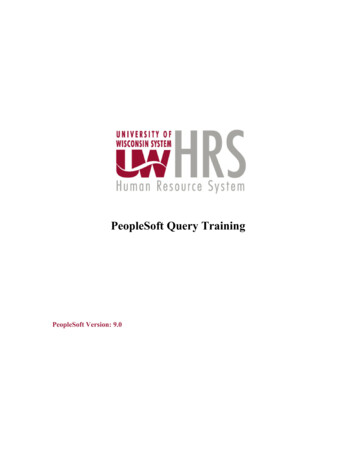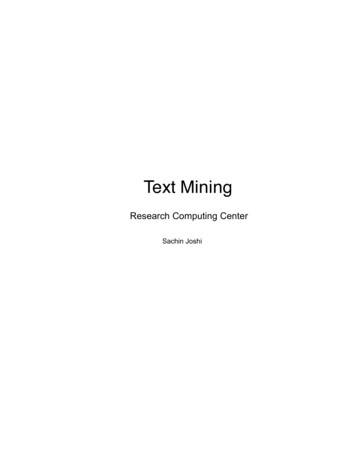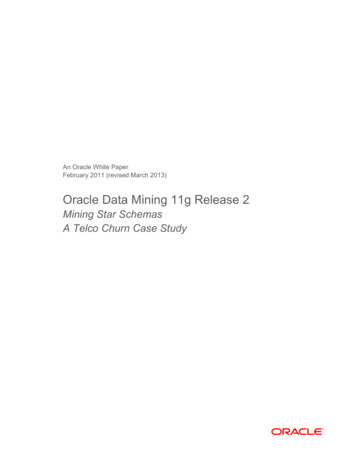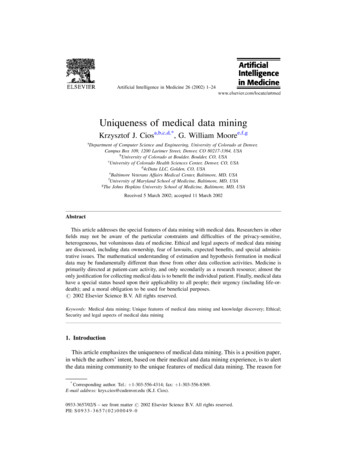
Transcription
Keyword: TutorialDatabase Queries, Data Mining, and OLAP2nd EditionLutz HamelDepartment of Computer Science and StatisticsUniversity of Rhode IslandTyler HallKingston, RI 02881Tel: (401) 480-9499Fax: (401) 874-4617Email: hamel@cs.uri.edu
Database Queries, Data Mining, and OLAPLutz Hamel, University of Rhode Island, USAINTRODUCTIONModern, commercially available relational database systems now routinely includea cadre of data retrieval and analysis tools. Here we shed some light on theinterrelationships between the most common tools and components included in today’sdatabase systems: query language engines, data mining components, and on-lineanalytical processing (OLAP) tools. We do so by pair-wise juxtaposition which willunderscore their differences and highlight their complementary value.BACKGROUNDToday’s commercially available relational database systems now routinely includetools such as SQL database query engines, data mining components, and OLAP (Craig,Vivona, & Bercovitch, 1999; Hamm, 2007; Melomed, Gorbach, Berger, & Bateman,2006; Scalzo, 2003; Seidman, 2001). These tools allow developers to construct highpowered business intelligence (BI) applications which are not only able to retrieverecords efficiently but also support sophisticated analyses such as customer classificationand market segmentation. However, with powerful tools so tightly integrated with thedatabase technology understanding the differences between these tools and theircomparative advantages and disadvantages becomes critical for effective applicationdevelopment. From the practitioner’s point of view questions like the following oftenarise:
Is running database queries against large tables considered data mining? Can data mining and OLAP be considered synonymous? Is OLAP simply a way to speed up certain SQL queries?The issue is being complicated even further by the fact that data analysis tools are oftenimplemented in terms of data retrieval functionality. Consider the data mining models inthe Microsoft SQL server which are implemented through extensions to the SQLdatabase query language (e.g. predict join) (Seidman, 2001) or the proposed SQLextensions to enable decision tree classifiers (Sattler & Dunemann, 2001). OLAP cubedefinition is routinely accomplished via the data definition language (DDL) facilities ofSQL by specifying either a star or snowflake schema (Kimball, 1996).MAIN THRUST OF THE CHAPTERThe following sections contain the pair wise comparisons between the tools andcomponents considered in this chapter.Database Queries vs. Data MiningVirtually all modern, commercial database systems are based on the relationalmodel formalized by Codd in the 60s and 70s (Codd, 1970) and the SQL language (Date,2000) which allows the user to efficiently and effectively manipulate a database. In thismodel a database table is a representation of a mathematical relation, that is, a set ofitems that share certain characteristics or attributes. Here, each table column represents anattribute of the relation and each record in the table represents a member of this relation.In relational databases the tables are usually named after the kind of relation they
represent. Figure 1 is an example of a table that represents the set or relation of all thecustomers of a particular store. In this case the store tracks the total amount of moneyspent by its customers.Figure 1: A relational database table representing customers of a store.IdNa meZIPSexAg eIncomeChildrenCar5Peter05566M35 40,0002 22 Mau reen 04477 F 26 55,000 0MiniVan CoupeTotalSpent 250.00 50.00Relational databases do not only allow for the creation of tables but also for themanipulation of the tables and the data within them. The most fundamental operation ona database is the query. This operation enables the user to retrieve data from databasetables by asserting that the retrieved data needs to fulfill certain criteria. As an example,consider the fact that the store owner might be interested in finding out which customersspent more than 100 at the store. The following query returns all the customers from theabove customer table that spent more than 100:SELECT * FROM CUSTOMER TABLE WHERE TOTAL SPENT 100;This query returns a list of all instances in the table where the value of the attributeTotal Spent is larger than 100. As this example highlights, queries act as filters thatallow the user to select instances from a table based on certain attribute values. It does
not matter how large or small the database table is, a query will simply return all theinstances from a table that satisfy the attribute value constraints given in the query. Thisstraightforward approach to retrieving data from a database has also a drawback. Assumefor a moment that our example store is a large store with tens of thousands of customers(perhaps an online store). Firing the above query against the customer table in thedatabase will most likely produce a result set containing a very large number ofcustomers and not much can be learned from this query except for the fact that a largenumber of customers spent more than 100 at the store. Our innate analytical capabilitiesare quickly overwhelmed by large volumes of data.This is where differences between querying a database and mining a databasesurface.In contrast to a query which simply returns the data that fulfills certainconstraints, data mining constructs models of the data in question. The models can beviewed as high level summaries of the underlying data and are in most cases more usefulthan the raw data, since in a business sense they usually represent understandable andactionable items (Berry & Linoff, 2004). Depending on the questions of interest, datamining models can take on very different forms. They include decision trees and decisionrules for classification tasks, association rules for market basket analysis, as well asclustering for market segmentation among many other possible models. Good overviewsof current data mining techniques and models can be found in (Berry & Linoff, 2004;Han & Kamber, 2001; Hand, Mannila, & Smyth, 2001; Hastie, Tibshirani, & Friedman,2001).
To continue our store example, in contrast to a query, a data mining algorithm thatconstructs decision rules might return the following set of rules for customers that spentmore than 100 from the store database:IF AGE 35 AND CAR MINIVAN THEN TOTAL SPENT 100ORIF SEX M AND ZIP 05566 THEN TOTAL SPENT 100These rules are understandable because they summarize hundreds, possiblythousands, of records in the customer database and it would be difficult to glean thisinformation off the query result. The rules are also actionable. Consider that the first ruletells the store owner that adults over the age of 35 that own a mini van are likely to spendmore than 100. Having access to this information allows the store owner to adjust theinventory to cater to this segment of the population, assuming that this represents adesirable cross-section of the customer base.Similar with the second rule, malecustomers that reside in a certain ZIP code are likely to spend more than 100. Lookingat census information for this particular ZIP code the store owner could again adjust thestore inventory to also cater to this population segment presumably increasing theattractiveness of the store and thereby increasing sales.As we have shown, the fundamental difference between database queries and datamining is the fact that in contrast to queries data mining does not return raw data thatsatisfies certain constraints, but returns models of the data in question. These models areattractive because in general they represent understandable and actionable items. Since
no such modeling ever occurs in database queries we do not consider running queriesagainst database tables as data mining, it does not matter how large the tables are.Database Queries vs. OLAPIn a typical relational database queries are posed against a set of normalizeddatabase tables in order to retrieve instances that fulfill certain constraints on theirattribute values (Date, 2000). The normalized tables are usually associated with eachother via primary/foreign keys. For example, a normalized database of our store withmultiple store locations or sales units might look something like the database given inFigure 2. Here, PK and FK indicate primary and foreign keys, respectively.Figure 2: Normalized database schema for a store.
From a user perspective it might be interesting to ask some of the followingquestions: How much did sales unit A earn in January? How much did sales unit B earn in February? What was their combined sales amount for the first quarter?Even though it is possible to extract this information with standard SQL queries from ourdatabase, the normalized nature of the database makes the formulation of the appropriateSQL queries very difficult. Furthermore, the query process is likely to be slow due to thefact that it must perform complex joins and multiple scans of entire database tables inorder to compute the desired aggregates.By rearranging the database tables in a slightly different manner and using aprocess called pre-aggregation or computing cubes the above questions can be answeredwith much less computational power enabling a real time analysis of aggregate attributevalues – OLAP (Craig et al., 1999; Kimball, 1996; Scalzo, 2003). In order to enableOLAP, the database tables are usually arranged into a star schema where the inner-mosttable is called the fact table and the outer tables are called dimension tables. Figure 3shows a star schema representation of our store organized along the main dimensions ofthe store business: customers, sales units, products, and time.
Figure 3: Star schema for a store database.The dimension tables give rise to the dimensions in the pre-aggregated data cubes.The fact table relates the dimensions to each other and specifies the measures which areto be aggregated.Here the measures are “dollar total”, “sales tax”, and“shipping charge”. Figure 4 shows a three-dimensional data cube pre-aggregated fromthe star schema in Figure 3 (in this cube we ignored the customer dimension, since it isdifficult to illustrate four-dimensional cubes). In the cube building process the measuresare aggregated along the smallest unit in each dimension giving rise to small preaggregated segments in a cube.
Data cubes can be seen as a compact representation of pre-computed query resultsi.Essentially, each segment in a data cube represents a pre-computed query result to aparticular query within a given star schema. The efficiency of cube querying allows theuser to interactively move from one segment in the cube to another enabling theinspection of query results in real time. Cube querying also allows the user to group andungroup segments, as well as project segments onto given dimensions. This correspondsto such OLAP operations as roll-ups, drill-downs, and slice-and-dice, respectively (Gray,Bosworth, Layman, & Pirahesh, 1997). These specialized operations in turn provideanswers to the kind of questions mentioned above.Figure 4: A three-dimensional data cube.As we have seen, OLAP is enabled by organizing a relational database in a waythat allows for the pre-aggregation of certain query results. The resulting data cubes holdthe pre-aggregated results giving the user the ability to analyze these aggregated results in
real time using specialized OLAP operations. In a larger context we can view OLAP as amethodology for the organization of databases along the dimensions of a business makingthe database more comprehensible to the end user.Data Mining vs. OLAPIs OLAP data mining? As we have seen, OLAP is enabled by a change to the datadefinition of a relational database in such a way that it allows for the pre-computation ofcertain query results. OLAP itself is a way to look at these pre-aggregated query resultsin real time. However, OLAP itself is still simply a way to evaluate queries which isdifferent from building models of the data as in data mining. Therefore, from a technicalpoint of view we cannot consider OLAP to be data mining. Where data mining toolsmodel data and return actionable rules, OLAP allows users to compare and contrastmeasures along business dimensions in real time.It is interesting to note, that recently a tight integration of data mining and OLAPhas occurred. For example, Microsoft SQL Server 2000 not only allows OLAP tools toaccess the data cubes but also enables its data mining tools to mine data cubes (Seidman,2001).FUTURE TRENDSPerhaps the most important trend in the area of data mining and relationaldatabases is the liberation of data mining tools from the “single table requirement”. Thisnew breed of data mining algorithms is able to take advantage of the full relationalstructure of a relational database obviating the need of constructing a single table that
contains all the information to be used in the data mining task (Dézeroski & Lavraéc,2001; Getoor, L., & Taskar, B., 2007).This allows for data mining tasks to berepresented naturally in terms of the actual database structures, e.g. (Yin, Han, Yang, &Yu, 2004), and also allows for a natural and tight integration of data mining tools withrelational databases.CONCLUSIONModern, commercially available relational database systems now routinely includea cadre of data retrieval and analysis tools. Here, we briefly described and contrasted themost often bundled tools: SQL database query engines, data mining components, andOLAP tools. Contrary to many assertions in the literature and business press, performingqueries on large tables or manipulating query data via OLAP tools is not considered datamining due to the fact that no data modeling occurs in these tools. On the other hand,these three tools complement each other and allow developers to pick the tool that is rightfor their application: queries allow ad hoc access to virtually any instance in a database;data mining tools can generate high-level, actionable summaries of data residing indatabase tables; and OLAP allows for real-time access to pre-aggregated measures alongimportant business dimensions. In this light it does not seem surprising that all threetools are now routinely bundled.REFERENCESBerry, M. J. A., & Linoff, G. S. (2004). Data Mining Techniques : For Marketing, Sales,and Customer Relationship Management (2nd ed.): John Wiley & Sons.
Codd, E. F. (1970). A Relational Model of Data for Large Shared Data Banks.Communications of the ACM, 13(6), 377-387.Craig, R. S., Vivona, J. A., & Bercovitch, D. (1999). Microsoft Data Warehousing: JohnWiley & Sons.Date, C. J. (2000). An introduction to database systems (7th ed.). Reading, Mass.:Addison-Wesley.Dézeroski, S., & Lavraéc, N. (2001). Relational data mining. Berlin ; New York:Springer.Getoor, L., & Taskar, B., eds. (2007). Introduction to Statistical Relational Learning,MIT Press.Gray, J., Bosworth, A., Layman, A., & Pirahesh, H. (1997). Data Cube: A RelationalAggregation Operator Generalizing Group-By, Cross-Tab, and Sub-Totals. DataMining and Knowledge Discovery, 1(1), 29-53.Hamm, C. (2007). Oracle Data Mining. Rampant Press.Han, J., & Kamber, M. (2001). Data mining : concepts and techniques. San Francisco:Morgan Kaufmann Publishers.Hand, D. J., Mannila, H., & Smyth, P. (2001). Principles of data mining. Cambridge,Mass.: MIT Press.Hastie, T., Tibshirani, R., & Friedman, J. H. (2001). The elements of statistical learning :data mining, inference, and prediction. New York: Springer.Kimball, R. (1996). The data warehouse toolkit : practical techniques for buildingdimensional data warehouses. New York: John Wiley & Sons.
Melomed, E., Gorbach, I., Berger, A., & Bateman, P. (2006). Microsoft SQL Server 2005Analysis Services. Sams.Pendse, N. (2001). Multidimensional data structures, ler, K., & Dunemann, O. (2001, November 5-10). SQL Database Primitives forDecision Tree Classifiers. Paper presented at the 10th International Conference onInformation and Knowledge Management, Atlanta, Georgia.Scalzo, B. (2003). Oracle DBA guide to data warehousing and star schemas. UpperSaddle River, N.J.: Prentice Hall PTR.Seidman, C. (2001). Data Mining with Microsoft SQL Server 2000 Technical Reference:Microsoft Press.Yin, X., Han, J., Yang, J., & Yu, P. S. (2004). CrossMine: Efficient Classification AcrossMultiple Database Relations. Paper presented at the 20th International Conferenceon Data Engineering (ICDE 2004), Boston, MA, USA.TERMS AND THEIR DEFINITIONSQL: Structured Query Language - SQL is a standardized programming language fordefining, retrieving, and inserting data objects in relational databases.OLAP: On-Line Analytical Processing - a category of applications and technologies forcollecting, managing, processing and presenting multidimensional data for analysis andmanagement purposes. (Source: http://www.olapreport.com/glossary.htm)
Star Schema: A database design that is based on a central detail fact table linked tosurrounding dimension tables. Star schemas allow access to data using business termsand perspectives. (Source: d Database: A database design that arranges data in such a way that it is heldat its lowest level avoiding redundant attributes, keys, and relationships.(Source: http://www.oranz.co.uk/glossary text.htm)Query: This term generally refers to databases. A query is used to retrieve databaserecords that match certain criteria.(Source: http://usa.visa.com/business/merchants/online trans glossary.html)Business Intelligence: Business intelligence (BI) is a broad category of technologies thatallows for gathering, storing, accessing and analyzing data to help business users makebetter decisions. (Source: http://www.oranz.co.uk/glossary text.htm)Data Cubes: Also known as OLAP cubes. Data stored in a format that allows users toperform fast multi-dimensional analysis across different points of view. The data is oftensourced from a data warehouse and relates to a particular business function.(Source: http://www.oranz.co.uk/glossary text.htm)Figures 2 and 3 are based on Figures 3.2 and 3.3 from (Craig et al., 1999), respectively.
iAnother interpretation of data cubes is as an effective representation of multidimensional data along themain business dimensions (Pendse, 2001).
As we have shown, the fundamental difference between database queries and data mining is the fact that in contrast to queries data mining does not return raw data that satisfies certain constraints, but returns models of the data in question. These models are attractive because in general they represent understandable and actionable items. Since










